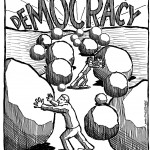 When we hear the word “democracy” we usually think “politics.” So how is organizational politics different? Worldblu.com (a global network of organizations committed to practicing freedom and democracy in the workplace) explains the difference perfectly: “Organizational democracy is a system of organization that is based on freedom, instead of fear and control. It’s a way of designing organizations to amplify the possibilities of human potential — and the organization as a whole. The concept of democracy comes from the Greek words “demos” and “kratein” which mean “the people rule”. So the core of organizational democracy and political democracy is the same — allowing people to self-govern and determine their own destiny. What is different is the context — one is in the political arena, the other is in the realm of organizations.”
When we hear the word “democracy” we usually think “politics.” So how is organizational politics different? Worldblu.com (a global network of organizations committed to practicing freedom and democracy in the workplace) explains the difference perfectly: “Organizational democracy is a system of organization that is based on freedom, instead of fear and control. It’s a way of designing organizations to amplify the possibilities of human potential — and the organization as a whole. The concept of democracy comes from the Greek words “demos” and “kratein” which mean “the people rule”. So the core of organizational democracy and political democracy is the same — allowing people to self-govern and determine their own destiny. What is different is the context — one is in the political arena, the other is in the realm of organizations.”
In a democratic workplace relationships are peer-to-peer rather than parent-child. The democratic workplace environment thrives on accountability, transparency, choice and the decentralization of power. And the result of this is that people are empowered so that their full potential is unlocked to contribute to the organization in an effective and meaningful way.
Worldblu.com (referred to above) talks about the core principles of a democratic workplace, and one of the core principles is the transparency of information – this may include the transparency of financial information, agenda and strategy. When information is transparent, employees can then have the information they need to make smart, empowered decisions – and that contributes to greater efficiency and innovation. Transparency contributes to trust and it also makes people feel that they matter – that they are valued, empowered and given a voice.
Bureaucracy often serves to hide innovative ideas and creativity whereas a transparent, democratic company is much more innovative and that translates to the bottom line – democratic companies can adjust to market changes, they have higher productivity and efficiency, and lower absenteeism – obviously making it a better strategic model for a company.
So, what are the implications for learning in the workplace?
With transparency comes conversation – and with conversation comes a more engaged organization. Effective workplace learning requires this engagement and Enterprise 2.0 and Social Business are founded on organizational democracy. Under traditional command & control management neither can thrive, and organizational change cannot take place. And organizational learning is fundamental change.
Author Peter Senge talks about five disciplines in his classic book, The Fifth Discipline (1990), which focuses on group problem solving using the ‘systems thinking method’ in order to convert companies into learning organizations. The five disciplines represent approaches for developing the following core learning capabilities: fostering aspiration, developing reflective conversation, and understanding complexity. This book dates back to 1990, yet this is still not what we see in learning organizations today. Our social systems (inside and outside the work environment) are not designed to cope with complexity and change – in other words, learning. Therefore, we need to rethink, reorganize and redesign – and adopt a democratic workplace, replacing hierarchy with a flattened organization so that communication channels are opened, employees become engaged and learning can take place.
In “Why aren’t we all working for Learning Organisations?,” the authors John Seddon and Brendan O’Donovan conclude:
“Our argument is that Deming’s statements in his 1990 review of Senge’s work continue to hold true: it is the dominance of the command and control management thinking which, 20 years on, still prevails and prevents the development of more generative learning. It is only by studying an organisation as a system and creating double-loop learning [real critical thinking] that we might finally see Senge’s ‘learning organizations’ stop being the exceptional and instead become the norm.”
By @rgogos


